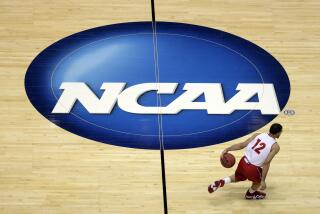Sandusky fallout: NCAA ‘death penalty’ possible for Penn State
With Penn State University expected within days to respond to NCAA concerns about how the school handled reports involving former assistant football coach Jerry Sandusky and allegations of child sexual abuse, the real question for sports fans is whether, and how, the celebrated football program will be punished.
The NCAA, the governing body of collegiate sports, is not likely to act quickly enough for there to be any action before the football season opener scheduled for Sept. 1 against Ohio University. The Nittany Lions have the dubious pleasure of opening at home, at Beaver Stadium. That stadium has been the focus of protests about a statue of Joe Paterno, the late head football coach, who was portrayed in less-than-flattering terms in the recent university-sponsored report on the Sandusky scandal.
In a series of media interviews this week, Penn State President Rodney Erickson said that, now that the report by former FBI Director Louis Freeh has been made public, the university can move on to implementation of the recommendations and turn its attention to responding to NCAA.
PHOTOS: Who’s who in the Sandusky case
“The NCAA has indicated that they’d like me to respond … as quickly as possible now that we have the Freeh report,” Erickson said in interviews Tuesday. “So we’ve already started the process of starting to compose that response. We’ll do so over the course of the next few days and get that response back as soon as possible, and we’ll then engage in discussions with the NCAA.”
The NCAA, for its part, has taken nothing off the table, including the so-called death penalty, shutting down the program for at least a year, said its president Mark Emmert in a PBS interview Monday. Emmert said he’s “never seen anything as egregious as this in terms of just overall conduct and behavior inside a university.”
“Let’s not get ahead of ourselves here,” Erickson told the Associated Press on Tuesday. “Let’s wait for this process to unfold. President Emmert has said that the NCAA will take a deliberate and deliberative process in addressing this, so I don’t think we should jump to any conclusions at this point.”
The Freeh report blamed top university officials for failing -- not once, but twice -- to act on reports that Sandusky had sexually abused boys in the showers of the school’s football training facility. The officials acted to keep the reports in-house, despite legal requirements that they tell outside authorities, because they feared the impact of bad publicity on the school. The report also discussed a culture of fear that prevented anyone from acting against someone affiliated with the school’s powerful football program.
Sandusky is in jail awaiting sentencing on 45 counts of child sexual abuse and faces spending the rest of his life in prison. Two college administrators are facing charges of perjury and failing to report the abuse allegations to authorities. The former university president was forced out, as was Paterno, who died of cancer in January.
Paterno, who is blamed in the report for urging other officials to keep the Sandusky reports hidden, has seen his reputation diminished on an almost-daily basis. The university has said it will decide within 10 days whether to take down the Paterno statue, which would be a sharp blow to the many supporters and the memory of the Hall of Fame coach.
But for the NCAA, the inquiry will revolve around the association’s now-famous four questions to the school and the idea of “institutional control” and jurisdiction. The Freeh report found that the university didn’t act as it could have and made 120 recommendations that the school will probably implement to improve the future.
Jurisdiction is a tougher issue. So far, the NCAA has used only the failure-of-institutional-control argument in connection with violations that give schools a sports edge, supplying unofficial money to attract better players, for example. Moving into an area like the Sandusky scandal -- which had nothing to do with what was happening on the field -- would mark a change for the association.
Complicating the situation is the sheer economic weight of the football program at the school that earned its nickname as “Linebacker U.” for the gritty defensive style, owed in part to Sandusky. Citing federal filings, the Morning Call reports that Penn State’s football program grossed $72.7 million in 2010-11. Even deducting $19.5 million in expenses, the football team banked $53.2 million.
And that doesn’t count the usual multiplier effects on area hotels, restaurants, merchants and so forth.
So, while the NCAA will act at some point, probably not for at least another year, it is not expected to shut down Penn State’s football program.
ALSO:
Surprise! Would-be cafe robbers run into tough 71-year-old
Clue for families of missing Iowa girls: Dogs find scent at lake
Arizona sheriff Joe Arpaio dares George Lopez: Say it to my face
Join Michael on Google+. Email: [email protected]
More to Read
Sign up for Essential California
The most important California stories and recommendations in your inbox every morning.
You may occasionally receive promotional content from the Los Angeles Times.










